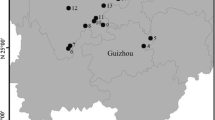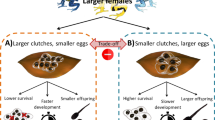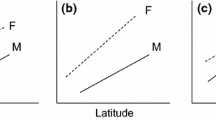Abstract
Interpopulation comparisons of variation in resource availability and in allocation patterns along altitudinal and latitudinal gradients allow insights into the mechanisms shaping the life history of animals. Patterns of between-population differences in female life history traits have been studied intensively across a wide range of taxa, but similar investigations in males have remained scarce. To study if testis weight—a measure of reproductive investment—varies on a geographical scale in anurans, we focussed on the variation in relative testis weight (RelTW) and asymmetry in 22 populations of the common frog Rana temporaria along a 1,600-km latitudinal transect across the Scandinavian peninsula. We found that RelTW decreased towards the north. Body mass and body length both had independent positive effects on testes mass. We found evidence for directional asymmetry (DA) in testis weight with the right testis being larger than the left. The level of DA in testis weight was not related to latitude, but both body mass and testes mass had independent positive effects on asymmetry. We discuss the northwards decrease in RelTW in terms of a decreased reproductive investment as a possible consequence of harsher environmental conditions, and perhaps also, weaker sexual selection in the north than in the south.



Similar content being viewed by others
References
Arak A (1982) Male–male competition and mate choice in frogs and toads. PhD thesis. University of Cambridge, Cambridge
Berven KA (1982) The genetic basis of altitudinal variation in the wood frog Rana sylvatica. I. An experimental analysis of life history traits. Evolution 36:962–983
Byrne P, Roberts JD, Simmons LW (2002) Sperm competition selects for increased testis mass in Australian frogs. J Evol Biol 15:347–355
Emerson SB (1997) Testis size variation in frogs: testing the alternatives. Behav Ecol Sociobiol 41:227–235
Elmberg J (1990) Long-term survival, length of the breeding season, and operational sex ratio in a boreal population of common frogs Rana temporaria L. Can J Zool 68:121–127
Elmberg J, Lundberg P (1991) Intraspecific variation in calling, time allocation and energy reserves in breeding male common frogs Rana temporaria. Ann Zool Fenn 28:23–29
Gibbons MM, McCarthy TK (1986) The reproductive output of frogs Rana temporaria (L.) with particular reference to body size and age. J Zool 209:579–593
Haapanen A (1982) Breeding of the common frog (Rana temporaria L.). Ann Zool Fenn 19:75–79
Harcourt AH, Harvey PH, Larson SG, Short RV (1981) Testis weight, body weight and breeding system in primates. Nature 293:55–57
Hönig J (1966) Über Eizahlen von Rana temporaria. Salamandra 2:70–72
Koskela P, Pasanen S (1975) The reproductive biology of the female common frog, Rana temporaria L., in northern Finland. Aquilo Ser Zool 16:1–12
Lack D (1966) Population studies on birds. Clarendon, Oxford
Laugen AT, Laurila A, Räsänen K, Merilä J (2003) Latitudinal countergradient variation in the common frog (Rana temporaria) development rates—evidence for local adaptation. J Evol Biol 16:996–1005
Laurila A, Seppä P (1998) Multiple paternity in the common frog (Rana temporaria): genetic evidence from tadpole kin groups. Biol J Linn Soc 63:221–232
Littell RC, Milliken GA, Stroup WW, Wolfinger RD (1996) SAS system for mixed models. SAS Institute, Cary, N.C.
Lüddecke H (2002) Variation and trade-offs in reproductive output of the Andean frog Hyla labialis. Oecologia 130:403–410
Møller AP (1994) Directional selection on directional asymmetry: testes size and secondary sexual characters in birds. Proc R Soc Lond Ser B 258:147–151
Palo JU, O’Hara RB, Laugen AT, Laurila A, Primmer CR, Merilä J (2003) Latitudinal divergence of common frog (Rana temporaria) life history traits by natural selection: evidence from a comparison of molecular and quantitative genetic data. Mol Ecol 12:1963–1978
Parker GA (1970) Sperm competition and its evolutionary consequences in insects. Biol Rev 45:525–567
Rowe G, Beebee TJC, Burke T (1999) Microsatellite heterozygosity, fitness and demography in natterjack toads Bufo calamita. Anim Conserv 2:85–92
Ryser J (1986) Altersstruktur, Geschlechtsverhältnis und Dynamik einer Grasfrosch-Population (Rana temporaria L.) aus der Schweiz. Zool Anz 217:234–251
Ryser J (1989) Weight loss, reproductive output, and the cost of reproduction in the common frog, Rana temporaria. Oecologia 78:264–268
Short RV (1979) Sexual selection and its component parts, somatic and genital selection, as illustrated by man and the great apes. Adv Stud Behav 9:131–158
Wells KD (1977) The social behaviour of anuran amphibians. Anim Behav 25:666–693
Acknowledgements
We thank S. Andersson, J. Elmberg, C. Gower, M. Pahkala, E. Karvonen, N. Kolm, A. T. Laugen, B. Lardner, J. Loman, K. Räsänen, and F. Söderman for help with the field work, and G. Hegyi, J. D. Roberts and J. Török for comments on the manuscript. This study was supported by the Swedish Natural Science Research Council (K. I. J., J. M.), Academy of Finland (A. L., J. M.), Swedish Forestry and Agriculture Research Foundation (J. M.) and LAPBIAT (A. H., G. H., T. K., J. M.). Collections were done in accordance with current laws in Sweden and Finland (permit no. C21/98 granted by the Ethical Committee of Uppsala University)
Author information
Authors and Affiliations
Corresponding author
Rights and permissions
About this article
Cite this article
Hettyey, A., Laurila, A., Herczeg, G. et al. Does testis weight decline towards the Subarctic? A case study on the common frog, Rana temporaria. Naturwissenschaften 92, 188–192 (2005). https://doi.org/10.1007/s00114-005-0607-3
Received:
Accepted:
Published:
Issue Date:
DOI: https://doi.org/10.1007/s00114-005-0607-3




